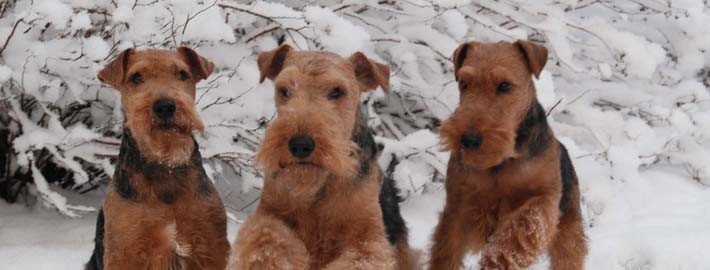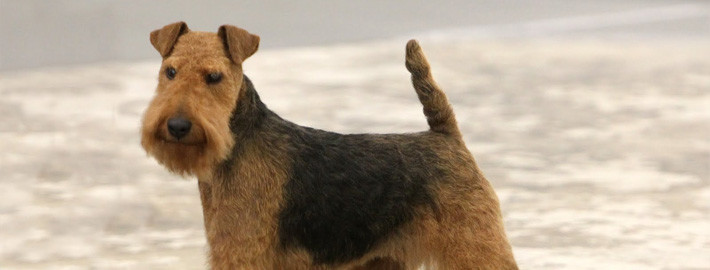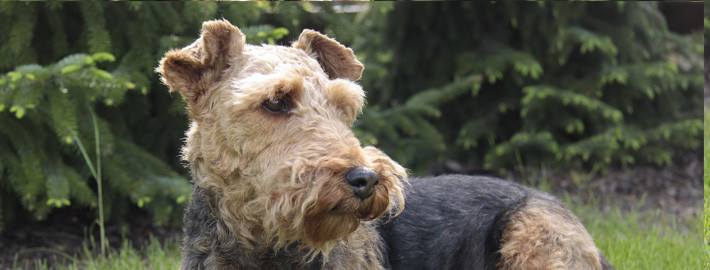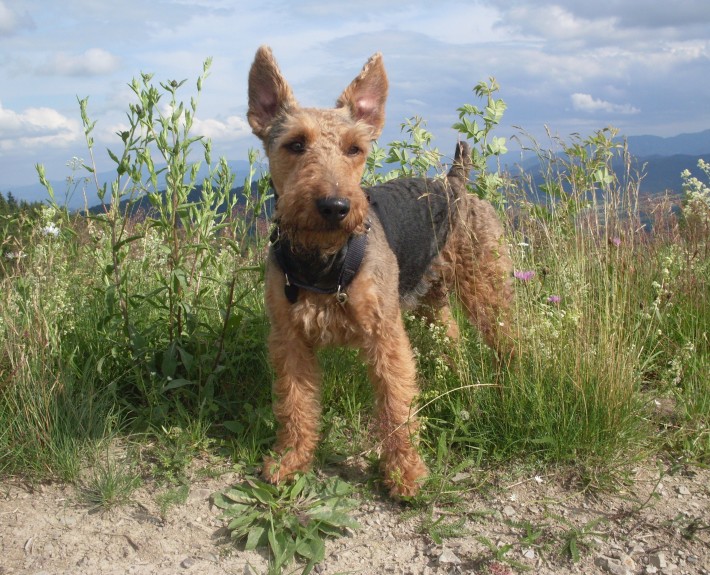What makes the Welsh Terrier Unique?
This highly trainable breed is native to Wales in the United Kingdom where they were historically used to hunt a variety of animals.
Page Contents
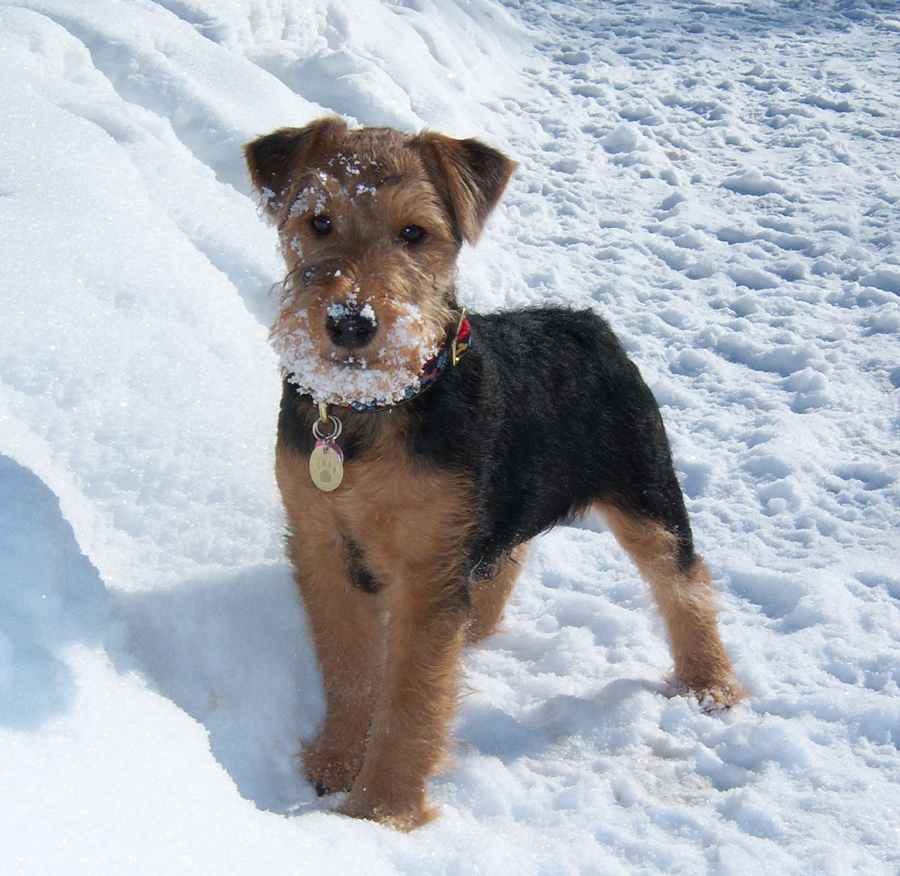
Is the Welsh Terrier Right For You?
These dogs tend to tote their toys and other items, such as socks, along with them wherever they go. Welsh Terriers do well as members of active young families because they are both eager to please and loyal to their human owners. These dogs also like to play and don’t mind a bit of roughhousing, which helps make them great companions for children.
These dogs should get their exercise from leashed walks or from playing in a securely fenced-in area because it is in their nature to chase whatever crosses their path. Members of this breed also tend to be geniuses at figuring out ways to escape.
In 5 Words
- Alert
- Rugged
- Friendly
- Bright
- Cheerful
Characteristics
Learn About the Welsh Terrier
Description
General Description
Due to earlier cross breeding practices, the modern Welsh Terrier resembles a small Airedale Terrier. These medium-sized dogs are quite sturdy with their square, stocky bodies and rectangular heads. Their backs should be level. Welsh Terriers should have an alert expression in their wide-set brown eyes. Members of this breed also possess slightly folded v-shaped ears. These dogs should have teeth that meet in either a level or scissors bite. Straight legs and cat like feet are other breed features. Welsh Terriers have a fluid, powerful gait and they are able to run quickly for long periods of time. Traditionally, these dogs would have the tips of their tails removed so that this appendage would be level with their head. However, in most parts of Europe, it is now illegal for owners to have their dog’s tail docked. Their dewclaws may also be removed.
Size
Male dogs of this breed typically measure between 15 and 15.5 inches in height. Female dogs average 15 inches tall. Although males can range from 18 to 21 pounds and females from 17 to 20 pounds, the ideal weight for Welsh Terriers of both genders is approximately 20 pounds.
Coat
These dogs have a double coat that is comprised of a soft inner layer and an outer one that is both coarse and thick. Members of this breed come in a variety of colorations including black, tan, white, reddish brown, and grizzle. Welsh Terriers are typically born completely black but their coats lighten with age, except for the dark markings on their backs.
Short History of the Welsh
The Black and Tan Rough Terriers that were common in the 18th and 19th centuries were among the ancestors of the modern Welsh Terrier. One particular strain of the Rough Terriers was used for working in conjunction with Otter Hounds during the late 1700s. This group of Rough Terriers resembled the Old English Broken Haired Terrier from Northern England and the two varieties were often classed together. Eventually both types of dog became Welsh Terriers. Members of this breed were used for hunting foxes, badgers, and otters. In 1886, the breed was given official status by the English Kennel Club. It was later crossed with Wire Fox Terriers to give it an Airedale-like appearance but these new modifications were not especially popular. Modern Welsh Terriers typically serve as family pets but a number of them also compete in the show ring as well.
Temperament
Member of this breed are friendly, lively, and inquisitive. Shyness is not usually a problem. These dogs tend to tote their toys and other items, such as socks, along with them wherever they go. Welsh Terriers do well as members of active young families because they are both eager to please and loyal to their human owners. These dogs also like to play and don’t mind a bit of roughhousing, which helps make them great companions for children. Members of this intelligent breed enjoy chasing things and are usually up for a good game of fetch. Because these dogs have a strong prey drive, they will go after any small animals they encounter and, therefore, should not be allowed to roam freely in an open space. Welsh Terriers are nonetheless at home in both rural and town environments. Some members of this breed like the water and may enjoy going for a swim.
Although Welsh Terriers are reasonably calm and can handle period of inactivity better than most of their contemporaries, they are still terriers at heart. This means that they require plentiful exercise and regular mental stimulation in order to keep them from getting into trouble. The ability of Welsh Terriers to get along with other dogs depends on the individual. Some may pick fights with other pets. Members of this breed may also be on their guard around unfamiliar persons. Barking and digging are breed traits that can become problematic for some owners. These dogs are also prone to taking over the household if they are indulged or pampered too much.
Caring for Your Welsh Terrier
General Health
Welsh Terriers are born in litters of 3 to 6 puppies and generally live about 11 years. As a rule, members of this breed are not prone to many severe health problems. However, a condition called luxated lens has been known to appear from time to time. This is a dislocation of the lens that can cause blindness in individual terriers. Thyroid conditions and epilepsy are then other major breed concerns. Minor eye problems and skin conditions are also present in certain Welsh Terrier bloodlines.
Care
Daily
A daily walk or run is recommended for members of this breed.
Weekly
These dogs need to have their facial hair combed at least twice per week. Owners will also need to brush their pet’s coat every other day or so. Regular tooth brushing is highly recommended as well to prevent foul breath and keep dogs from falling prey to preventable conditions.
Monthly
Flea, heartworm and tick prevention medications are a must for any breed of pet. These products are typically administered on a monthly basis.
Grooming & Bathing
Welsh Terriers do not shed much. However, they typically need their coats plucked three or four times per year. These dogs can be bathed on an as needed basis but care to should be taken to ensure that they are properly dried after their baths. Members of this breed can be messy when eating and drinking so some clean up may be required. It’s recommended that owners take care to keep their pet’s face clean because some members of this breed are prone to eye infections. Owners will additionally need to keep the fur around their dog’s ears, paws, and ears trimmed. It is a good idea to clip their toenails on a regular basis as well.
Exercise & Training
Because Welsh Terriers are hard to housebreak, they should probably be crate trained instead. These dogs should get their exercise from leashed walks or from playing in a securely fenced-in area because it is in their nature to chase whatever crosses their path. Members of this breed also tend to be geniuses at figuring out ways to escape. Individuals may learn how to jump fences, climb over them, or dig out. Therefore, owners should keep an eye on these dogs if they are left outdoors.

